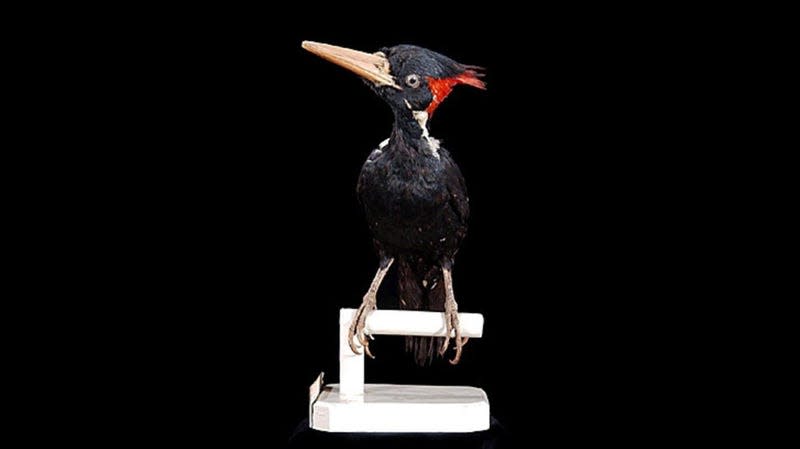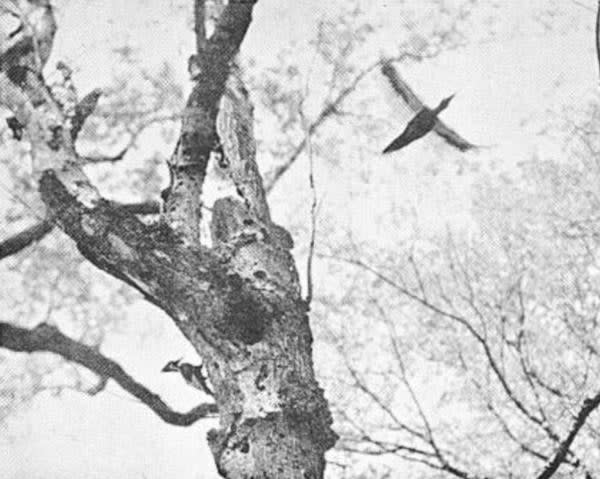Don’t Get Too Excited About Purported Videos of This Extinct Woodpecker

The ivory-billed woodpecker (Campephilus principalis) was a twenty-inch-long woodpecker native to the American southeast that has been presumed extinct since the mid-20th century.
But last month, a group of researchers announced evidence of “probable ivory-billed woodpeckers” that they recorded in Louisiana.
Read more
Their findings, published in Ecology and Evolution, included detailed analysis of (typically fuzzy) video footage the team captured of birds flying through the southern swamplands and clinging to trees, as well as audio footage which the team argues records the bird’s unique double-knocks and kent calls.
Like the thylacine (or Tasmanian tiger), a dog-like marsupial carnivore endemic to Tasmania, which was last conclusively alive in 1936, the ivory-billed woodpecker has become a symbol of humankind’s environmental destruction. Both species were threatened by habitat loss as well as human hunters. And both went extinct as video and audio recording materials were becoming more accessible and useful in the field.
Ivory-bills and thylacines both exist in the black-and-white limbo of video footage from zoos and their last wild habitats. Their sounds and behaviors were documented by few, and even those accounts vary widely in their descriptions of the animals. That’s made the work of those seeking to prove their existence more difficult, or easier, depending on what those seekers hope to see.
The last certifiable ivory-billed woodpecker sighting was 79 years ago, on trees that almost immediately were felled, on the Singer Tract in northern Louisiana. Over the intervening decades, audio, video, and photographic evidence has emerged purportedly showing that the species persists. The most famous evidence came out of a 2004 expedition led by ornithologists from Cornell University.
“From the very start, I personally and we generally at the lab never regarded my obligation as being trying to convince everybody that we were correct,” John Fitzpatrick, an ornithologist at Cornell University and the director emeritus of the university’s ornithology lab, who led the search, told Gizmodo in 2021. “We regarded our obligation—and I regarded my obligation—as making sure that we do our best at providing all the evidence we have and letting people draw their conclusions from the evidence we have.”
For all this work, no crystal-clear evidence of the ivory-bill has been brought to bear. Footage of ivory-bills taken in the 1930s remains clearer than any footage brought to bear since 1944.
Until such clear-cut (not to make a pun about their habitat loss) evidence comes about, all that the fuzzy footage will do is affirm the convictions of those who believe the bird is out there and further convince the skeptics that it certainly isn’t. So I’m not going to dwell on the video footage released with the recent paper; you can check it out yourself at the bottom of the paper, which is open-access. I’d be interested to hear in the comments what you make of them.
Does it really matter if the ivory-bill still exists? From a conservation perspective, certainly. But from the same perspective, resources should be spent on protecting the United States’ swamplands regardless of the bird’s status. There are over 1,300 endangered or threatened species in the country, according to the U.S. Fish & Wildlife Service. Having a fixation on one particular species isn’t going to help the ecosystem.

That was the crux of the service’s 2021 decision to delist the species as endangered (thereby declaring it extinct).
“The Endangered Species Act requires a species to be delisted due to recovery or extinction allowing the Service and its partners to better allocate resources,” Amy Trahan, a FWS biologist, told Gizmodo in an email shortly after the decision to delist.
“The determination to delist is based on the best available science at the time of the delisting,” Trahan added. “Extinction is difficult to detect, therefore, the Service makes reasonable conclusions based on the scientific information available.”
Indeed, extinction is nigh impossible to detect. You can always prove something is there, but you can rarely prove an animal is not there.
Invasive species shouldn’t get the same conservation protections as endemic species threatened by the former’s presence. But we should aim to document and protect the existence of as many creatures as we can. And ultimately, the conservation of life and the preservation of nature more generally should be prioritized over the hunt for proof of one bird.
As a species we’re making this difficult. Climate change is threatening nearly two-thirds of the United States’ birds, and entire ecosystems look increasingly vulnerable to rising temperatures. There are so many new broken records pertaining to climate change that we sound like a broken record.
If anyone wants to find the ivory-billed woodpecker, bully for them. I love majestic species as much as the next person. But conservation agencies should focus on doing the most good for the most species possible, prioritizing the most vulnerable. Presuming survival isn’t a bad thing, either, as long as that presumption doesn’t interfere with protecting other species.
Dozens of species go extinct daily, according to Yale University’s School of the Environment. Countless (literally, countless) species undergo anonymous (or “dark”) extinction: they were never documented by science before they disappeared from existence.
Meanwhile, companies are seeking—or at least claiming to seek—to “bring back” extinct species like the thylacine and the woolly mammoth, by hafting together the extinct creatures’ genetics with extant relatives.
It seems our relationship with long-gone creatures will never be as simple as mourning their loss (by our hand) and working to improve the situation of the creatures still around.
More: Why a Genome Can’t Bring Back an Extinct Animal
More from Gizmodo
Sign up for Gizmodo's Newsletter. For the latest news, Facebook, Twitter and Instagram.

